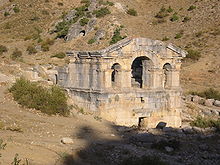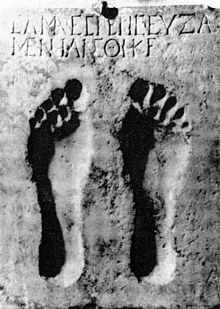Comana (Cappadocia)
 Comana | |
| Location | Şar,Adana Province,Turkey |
|---|---|
| Region | Cappadocia |
| Coordinates | 38°19′48″N36°19′48″E/ 38.33000°N 36.33000°E |
| Type | Settlement |
| Site notes | |
| Condition | In ruins |
Comanawas a city ofCappadocia(Greek:τὰ Κόμανα τῆς Καππαδοκίας) and laterCataonia(Latin:Comana Cataoniae;frequently calledComana Chryse[1]orAurea,i.e. "the golden", to distinguish it fromComana in Pontus). TheHittitetoponymKummanniis considered likely to refer to Comana, but the identification is not considered proven.[2]Its ruins are at the modernTurkishvillage ofŞarköy,Tufanbeylidistrict,Adana Province.[3]
History
[edit]According to ancient geographers, Comana was situated in Cappadocia (and later Cataonia[4]). Another epithet for the city, found in inscriptions, isHieropolis/ˌhaɪəˈræpəlɪs/ (Ancient Greek:Ἱεράπολις) 'sacred city', owing to a famous temple of the Syrian Moon goddess Enyo or, in the local language:Ma.StraboandJulius Caesarvisited it; the former[5]enters into long details about its position in a deep valley on theSarus(Seihoun) river. The temple and its fame in ancient times as the place where the rites ofMa-Enyo,a variety of the great west Asian nature-goddess, were celebrated with much solemnity. The service was carried on in a sumptuous temple with great magnificence by many thousands ofhierodouloi(temple slaves). To defray expenses, large estates had been set apart, which yielded a more than royal revenue. The city, a mere apanage of the temple, was governed directly by the chief priest, who was always a member of the reigning Cappadocian family, and took rank next to the king. The number of persons engaged in the service of the temple, even inStrabo's time, was upwards of 6,000, and among these, to judge by the names common on local tomb-stones, were many Persians.[6]Under the Romans the temple was reassigned toBellonaandLycomedesestablished as high priest. EmperorCaracallamade Comana a Roman colony, and the temple-city received honors from later emperors down to the official recognition ofChristianity.Comana Chryse, or the golden, appears from one of theNovellaeofJustinian(Nov.31. c. 1), to distinguish it from the Comana in Pontus. It was in the division which he named theThird Armenia,and which, he observes, containedMelitene,near theEuphrates.

There was a tradition thatOrestes,with his sister, brought fromTauric Scythiathe sacred rites of this temple, which were those of TauropolosArtemis.Here Orestes deposited the hair that he cut from his head to commemorate the end of his sufferings (ἡ πένθιμος κόμη), and hence, according to a folk etymology of the Greeks, came the name of the place, Comana. And in later times, to make the name suit the story better, as it was supposed, it was changed toἡ Κόμανα.(Eustath.ad Dionys.v. 694; Procop.Persic.i. 17.)
The city minted coins in antiquity that bear the epigraphsCol. Aug. Comana,andCol. Iul. Aug. ComanenoruorComainoru.
The site lies at Şarköy or Şar (once usually transcribed Shahr), a village in theAnti-Tauruson the upper course of theSarus(Sihun), mainlyArmenian,but surrounded by later settlements ofAvshar TurkomansandCircassians.The place has derived importance both in antiquity and now from its position at the eastern end of the main pass of the western Anti-Taurus range, theKuru Çay,through which passed the road fromCaesarea-Mazaca(modernKayseri) toMelitene(modernMalatya), converted bySeptimius Severusinto the chief military road to the eastern frontier of the empire. The extant remains at Şar include a theatre on the left bank of the river, a fine Roman doorway and many inscriptions; but the exact site of the great temple has not been satisfactorily identified. There are many traces of Severus's road, including a bridge at Kemer, and an immense number of milestones, some in their original positions, others reused in cemeteries.[6]
Ecclesiastical history
[edit]It remains a Roman Catholictitular seeof Asia Minor.St. Basiliscuswas put to death at Comana and was buried there; according to Palladius, the historian ofSt. Chrysostom,he was bishop of the city, but this is very doubtful. Its bishop, Elpidius, was present at theFirst Council of Nicaea,in 325. Leontius, a semi-Arian, held the see in the time of the Emperor Jovian. Bishop Heraclius appeared at theCouncil of Chalcedonin 451: Comana was then asuffraganofMelitene,the metropolis ofArmenia Secunda;since then it figures as such in most of theNotitiae episcopatuumto the twelfth century. Two other bishops are known: Hormizes, or Mormisdas, about 458 (letter to the Emperor Leo; see alsoPhotius,Biblioth., Cod. 51) and Theodorus at theFifth Ecumenical Council,in 553.
The ruins of Comana are visible ten miles north-west ofGuksun(Cocussus), in the Ottomanvilayet of Adana(Lequien,I, 447;William Mitchell Ramsay,The Historical Geography of Asia Minor).
Homonymous dioceses
[edit]- Another episcopal see namedComana,suffragan ofNeocaesarea,was situated inPontus Polemoniacus;it had also a temple of Ma and was surnamedHierocaesarea'Caesar's sacred [city]'. It was captured bySulla,83 B.C. Six bishops are mentioned by Lequien (I, 517); the first isSt. Alexander the Charcoal-Seller,consecrated bySt. Gregory the Wonder-Worker.This town became modernGomenek,orGomanak,a village south-west ofNeocaesarea(Niksar), in the Ottomanvilayet of Sivas.
- Lequien (I, 1009) gives another Comana inPamphylia Prima,suffragan ofSide;the true name is Conana.Zoticus,who lived at the time ofMontanus,was bishop of Conana in Pamphylia or of Comama in Pontus, not of Comana in Cappadocia. Cosmas of Conana appeared at theThird Council of Constantinoplein 680. Conana became modernGunen,in the Ottomanvilayet of Adana.
See also
[edit]- Saint John the Baptist,whose head was found at Comana in the 9th century, according to Church tradition
Sources and references
[edit]- ^Eustathius,Commentary on Dionysius,694) surnames it Chryse, "Golden".
- ^Sirkeli Archaeological ProjectArchived2009-01-05 at theWayback Machine
- ^Richard Talbert,Barrington Atlas of the Greek and Roman World,(ISBN0-691-03169-X), Map 64 & notes.
- ^Strabo, XI, 521
- ^Strabo, XI, 521; XII, 535, 537.
- ^abHogarth 1911.
- This article incorporates text from a publication now in thepublic domain:Hogarth, David George(1911). "Comana".InChisholm, Hugh(ed.).Encyclopædia Britannica.Vol. 6 (11th ed.). Cambridge University Press. p. 749.
 This article incorporates text from a publication now in thepublic domain:Herbermann, Charles, ed. (1908). "Comana".Catholic Encyclopedia.Vol. 4. New York: Robert Appleton Company.
This article incorporates text from a publication now in thepublic domain:Herbermann, Charles, ed. (1908). "Comana".Catholic Encyclopedia.Vol. 4. New York: Robert Appleton Company. This article incorporates text from a publication now in thepublic domain:Smith, William,ed. (1854–1857)."Comana".Dictionary of Greek and Roman Geography.London: John Murray.
This article incorporates text from a publication now in thepublic domain:Smith, William,ed. (1854–1857)."Comana".Dictionary of Greek and Roman Geography.London: John Murray.

